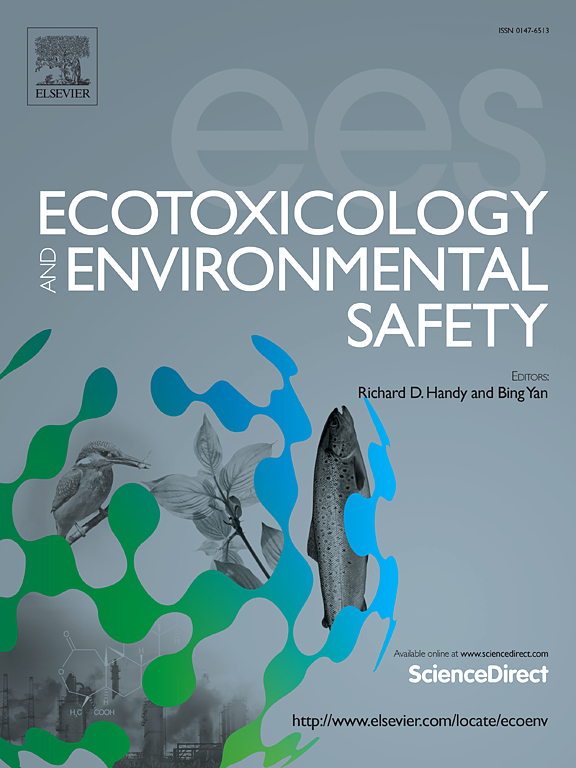Green synthesis of neem extract and neem oil-based azadirachtin nanopesticides for fall Armyworm control and management
IF 6.2
2区 环境科学与生态学
Q1 ENVIRONMENTAL SCIENCES
引用次数: 0
Abstract
The global spread of Fall Armyworm (FAW, Spodoptera frugiperda) has posed significant challenges to crop productivity and food security, with current pest management relying heavily on synthetic pesticides. This study explores the green synthesis of neem extract and neem oil-based Azadirachtin nanopesticides using cellulose acetate (CA) as a carrier polymer, focusing on their efficacy against FAW. The objective was to assess whether CA-NEP (neem extract nanopesticides) and CA-NOL (neem oil nanopesticide) formulations were effective at FAW control with minimal ecological impact. The nanopesticides were synthesized by electrospinning at concentrations of 5 %, 10 %, 20 %, 33 %, and 50 % (w/w) and characterized using Scanning Electron Microscopy and Fourier Transform Infrared spectroscopy. Azadirachtin content was quantified using Liquid Chromatography-Mass Spectroscopy. CA-NEP and CA-NOL followed first-order, and Korsmeyer-Peppas release kinetics, respectively. Feeding bioassays showed high FAW mortality rates, with 20 %-50 % CA-NEP achieving greater than 40 % mortality in less than 3 days and 50 % CA-NEP reaching 100 % mortality by day five. The mortality rates of FAW due to feeding on CA-NOL-treated corn leaves reached 40 % after 4 and 6 days, respectively, for 50 % and 33 % CA-NOL. Placing nanopesticide fibers next to corn seeds during planting significantly reduced FAW leaf damage. The lethal dose 50 (LD50) analyses showed that 13 % CA-NEP is the optimal concentration for FAW control. Environmental safety assessments on earthworms showed no acute or chronic toxicity, indicating that the nanopesticides suit ecologically sensitive areas. Therefore, these nanopesticide formulations provide a promising, eco-friendly alternative for sustainable FAW control and management with enhanced efficacy and safety.
绿色合成印楝提取物及印楝油基印楝素纳米杀虫剂防治秋粘虫
秋粘虫(FAW, Spodoptera frugiperda)在全球的传播对作物生产力和粮食安全构成了重大挑战,目前的病虫害管理严重依赖合成农药。本研究以醋酸纤维素(CA)为载体聚合物,探讨了印楝提取物和印楝油基印楝素纳米农药的绿色合成,重点研究了它们对一汽的防治效果。目的是评估CA-NEP(印楝提取物纳米农药)和CA-NOL(印楝油纳米农药)制剂是否能有效控制一汽,同时对生态影响最小。以5 %、10 %、20 %、33 %和50 % (w/w)为浓度,采用静电纺丝法合成了纳米农药,并用扫描电镜和傅里叶变换红外光谱对其进行了表征。采用液相色谱-质谱法测定印楝素含量。CA-NEP和CA-NOL分别服从一阶释放动力学和Korsmeyer-Peppas释放动力学。饲养生物测定显示FAW的死亡率很高,20 %-50 % CA-NEP在不到3天的时间内达到40 %以上的死亡率,50 % CA-NEP在第5天达到100 %的死亡率。对CA-NOL处理过的玉米叶片,4 d和6 d后一虫的死亡率分别为40 %和33 %,CA-NOL处理过的玉米叶片死亡率分别为50 %和33 %。种植期间在玉米种子旁放置纳米农药纤维可显著减少FAW对叶片的伤害。致死剂量50 (LD50)分析表明,13 % CA-NEP为FAW防治的最佳浓度。对蚯蚓的环境安全评价显示,纳米农药没有急性或慢性毒性,表明纳米农药适合生态敏感地区。因此,这些纳米农药配方为可持续的一汽控制和管理提供了一种有前景的、环保的替代方案,具有更高的功效和安全性。
本文章由计算机程序翻译,如有差异,请以英文原文为准。
求助全文
约1分钟内获得全文
求助全文
来源期刊
CiteScore
12.10
自引率
5.90%
发文量
1234
审稿时长
88 days
期刊介绍:
Ecotoxicology and Environmental Safety is a multi-disciplinary journal that focuses on understanding the exposure and effects of environmental contamination on organisms including human health. The scope of the journal covers three main themes. The topics within these themes, indicated below, include (but are not limited to) the following: Ecotoxicology、Environmental Chemistry、Environmental Safety etc.

 求助内容:
求助内容: 应助结果提醒方式:
应助结果提醒方式:


